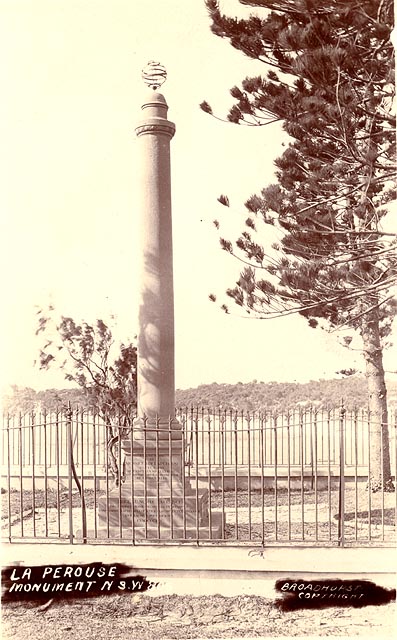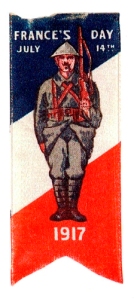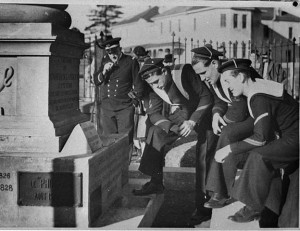The Foundation Stone of the Laperouse Monument was laid on the 6th September, 1825, by Hyacinthe de Bougainville. De Bougainville stopped over in Sydney for 3 months during a circumnavigation of the world. During that time he made observations about the new colony and forged a number of friendships and included amongst those friends was the astronomer Governor Brisbane. It was de Bougainville who commissioned the Laperouse Monument and the Receveur Tomb and the details of this are contained in his diaries, translated by Marc Serge Riviere in The Governor’s Noble Guest, Melbourne University Press, 1999, ISBN 0 522 84852 4.Page 110-113: Friday 26: Went on a pilgrimage to the spot visited by the crew of Mr de La Perouse in 1788 at Botany Bay. La Touane, Boissieu and I left in the company of Captain Piper on some of his horses. Boissieu who was a bad rider, failed to control his mount from the start and was forced to change horses The weather was superb, as we left the main road to Parramatta near Mr Stephen’s house and took the left turn which led to Botany Bay. Less than a mile from the junction, we entered a sandy area covered in scrub, grass trees, and then rode along large peat marshes that from a distance take on the appearance of cheerful meadows on account of a host of wild flowers. Yet, the marshes are very deep and perilous for cattle, which inevitably perish once they are bogged down. These marshes stretch all the way along the coast from Port Jackson to the bay, which owes its name to its treacherous nature.
We reached Cooks River, six miles from Port Jackson; winding its way near the bay, the river is not navigable. We sought a guide at that point to assist us in locating the French Camp, known here s the French Garden, fifteen miles from Sydney. We passed in front of a factory that manufactures hats, woolen cloth (the best type costs fifteen shillings a yard) and rough blankets; Mr Simeon Lord is the owner of the factory. The machines appeared complicated to me; they are driven by a gentle current of water. The factory employs twenty men and eight children and produces about 170 blankets per month that sell for a pound each. There is also a unit that manufactures stockings and employs a single worker; six dozen pairs of stockings are manufactured each month at a piastre each.
After visiting this factory, we entered paddocks, which were under water at the time and extended to the shore. The low tide allowed us to follow the shoreline and explore the northern part of the bay; we never lost sight of the river, which flows through Liverpool, twenty-five miles away, and is navigable. We also sighted a single dwelling, belonging to an old man, that is built a short distance within the southern head of the entrance of Botany Bay (Cape Solander). His is the only house built in this part of New South Wales. On the cape mentioned above, Governor Brisbane has had a monument erected with a plaque commemorating the first landing of the illustrious Cook. However, such is its position that one cannot read the inscription that consequently serves no purpose. Having ridden almost four miles along the beach at a gallop, we entered a wood at a point marked by a cottage with a small garden, and after travelling two miles, we at last reached French Garden, led by our tireless guide. We had the greatest difficulty in keeping up with him, and he ran seven miles in all from Cook’s River to our final destination.
The site chosen by Mr de La Perouse as a construction yard for new boats was located at the tip of the second headland on the starboard side of the entrance to the bay. It is on an exposed plateau that slopes down slightly towards the sea; one could still see the original holes dug for the posts that held up the barricades. These had been erected to offer protection against possible attacks by local Aborigines. At the foot of the cliff, there was a small cove where the sandy beach makes a landing easy. Three hundred yards to the north is located the turret, built in the style of an ancient amphitheatre, that serves as a guardhouse for the detachment. Its duties are to keep watch on this part of the coast; it consists of a corporal and three soldiers. The former led me to the grave of Father Receveur; the spot is marked by an inscription left on a tree by the officers of the corvette the Coquille. The grave consists of a pile of stones, and a cross bears the following inscription:
Near this tree are the remains of Father Receveur. Visited In March 1824.
As soon as I had heard that there were relics of the La Perouse’s stopover in Botany Bay, I had hit upon the idea of erecting a monument to our illustrious and unfortunate compatriot on the very spot from which his last message had been dispatched. I had revealed my plans to Captain Piper on the forward journey, and at once after our arrival, we set about determining the exact location of the proposed monument. La Touane drew a plan of the site without delay, and I entrusted him with the task of providing a sketch of the mausoleum; I inteneded asking the governor for official permission to erect it. In my view, such a tribute to the memory of our dear departed French comrades long overdue.
It was on 10 March 1788 that the frigates the Boussole and the Astrolabe set sail from Botany Bay. According to Mr de La Perouse’s last dispatch of 7 February of the same year (the last to be received), he was to head for the Loyalty Islands to visit the southern part of New Caledonia, Mendana’s Santa Cruz, the south coast of Surville’s Solomon Islands, to ascertain whether Bougainville’s Louisiade Archipelago formed part of New Guinea and explore New Holland through a channel other than that of the Endeavour. He was also to stop at the Gulf of Carpentaria and explore the entire west coat of New Holland as far as Van Diemen’s Land, and leave himself enough time to head north and reach Ile de France in November 1788.
While we were resting, La Touane drew both headlands at the entrance of Botany Bay. We tasted the bread made by the detachment, which I deemed excellent. Then we mounted and made haste lest the high tide would prevent us from riding along the shore. We caught sight of thousands of trevally fish which swam slowly and in schools. One cast of the net yielded 150 fish similar in size and shape to perches. Eages hovering above sometimes swooped down on them and ate them at will. At 5p.m., we reached Captain Piper’s residence, where my skill was tied up; we disembarked at the gardens of Government House and went on a leisurely walk as far as the point along Mrs Macquarie’s Road where we embarked in the skiff and returned to the ship.
(page 121) Sunday 4(September): The day before yesterday, Mr Cookney, the government architect, handed over to Governor Brisbane the commissioned plans for the monument to be designed in Tuscan and Doric style.
Monday 5(September): The government architect, Mr Cookney, came to have lunch with me and we discussed the details of the monument in honour of La Perouse. I chose the Tuscan style. The column will be almost 23 feet high.
Tuesday 6 (September): Messrs Piper, Ducamper, Longueville, Penaud, Chedeville and I set out on horseback. On the way, we collected Major Ovens and Mr James Macarthur and headed for Botany Bay. We reached the French camp of La Perouse and having selected the site for the monmnet, we marked the area that the governor had granted me for this purpose. As masons had prepared the site, I laid the first stone and Mr Chedeville took the minutes of the proceedings. Major Ovens and Captain Piper represented the governor who was unable to attend on account of the death of his father-in-law. We also measured the area to be fenced in where stood the grave of Father Receveur and the tree that bore the inscription; the purser noted down all the details. We drank a toast to the dearly departed, in keeping with an old English tradition. We left at 3 p.m. and took a different route through rocks, scrub land and marshes etc., along the coast.
Wednesday 7(September): I drafted the following inscription for the monument in honour of Mr de La Perouse: This land which he visited in 1788 is the last from where he sent a message!…This monument was erected on behalf of the French government by Messrs de Bougainville and Ducamper who were in command of the frigates La thetis and L’Esperance during their stopover at Port Jackson in 1825.
The same inscription in English was to be placed on the opposite side. Additional information was to be given on the other two sides.
A copper plaque, in which would be inserted gold and silver coins, would be embedded into the foundations and would bear the following inscription: This monument was erected in 1825 during the reign of Charles X in memory of Mr de La Perouse by Baron de Bougainville, who was in command of a French naval division consisting of the corvette La Thetis and the corvette L’Esperance under the command of Captain Ducamper.
Two Cypress trees and a Norfolk Pine will be planted in one row behind the monument and within an enclosing wall twelve feet square and two feet high, on which would be placed an iron grill.
Riviere writes: (pages 245-248) Hyacinthe de Bougainville’s decision to approach Governor Brisbane and to commit official funds to the project before securing the permission of the French government was a spontaneous one and was entirely his own initiative. He may have consulted his second-in-command, Ducamper, but he had no doubts that this was something that he simply had to do before leaving Australia. His writings convey his personal commitment to the project and his determination to complete it. In the event of the French government turning down his request, the Baron was prepared to invest his own money, as he indicates in his notebooks. On 13 September 1825, a few days before his expedition sailed from Prot Jackson, Hyacinthe de Bougainville wrote in an official dispatch to the Minister for the Navy:
Your Excellency will also find enclosed the description of the first stages of the erection of a monument in memory of M. de La Perouse. Following my visit to the spot where this illustrious navigator had set up camp during his stopover at Botany Bay, the memories this occasion evoked led to a resolution to erect a monument on the very shore from which our unfortunate compatriots had sent their last message back home. I discussed my plans with Governor Brisbane who welcomed them all the more since on the opposite side of the bay, he himself had recently arranged for a plaque to commemorate the arrival of the immortal Cook. H.E. had no hesitation in granting me the requested site and has kindly agreed to entrust the creation of the mausoleum to the government architect. Plans have been drawn up and an estimate of the costs has been arrived at for a monument which will be completed in four years. On my return to France, I shall have the great honour of presenting to you all the documents pertaining to the negotiations in the hope that Your Excellency will approve of my actions on France’s behalf, aimed at commemorating a man who has been mourned by the whole nation.
Largely as a personal favour to Hyacinthe de Bougainville, the generous Brisbane, who had a great deal of affection for France and was corresponding member of the French Academy of Science, granted an area of 176 square yards for the monument and a further seventy square yards for Father Receveur’s grave, which was located 136 yards from the monument. The ceremony during which the first stone was laid on 6 September 1825 was recorded in minutes.
Minutes of the ceremony of the erection of a monument in honour to M.de La perouse
Today 6 September 1825 at one o’clock in the afternoon in Botany Bay,
The Baron de Bougainville, Captain, in command of the naval division, accompanied by M. Ducamper, Captain, in command of the corvette Esperance, Longueville, Captain, Penaud, a midshipman and the clerk Chedeville,
And in the presence of Major John Ovens, Engineer and of John Piper, Naval Officer, who represented the Governor, Sir Thomas Brisbane, and of Mr James Macarthus,
Has laid the first stone of a monument to commemorate the stopover in this country by the expedition under the command of M.de La Perouse.
The English government has granted an area consisting of 176 square yards(126.867 square metres) which were part of the Garden where this navigator left plants and seeds with which he wanted to enrich this region.
The same government has also made a concession of 70 square yards (64.029 square metres) where had been buried the body of Father Receveur, the chaplain and naturalist of the Astrolabe, whose grave was situated near a tree which bore the following inscription:
“Near this tree was buried Father Receveur. Visited in March 1824”
This grave and this tree are a distance of 136 yards (124.94 metres) from the monument. Botany Bay (New Holland), On this day, month and year, Signed by: Chedeville, Penaud, Bougainville, Ducamper, Ovens, Piper, Macarthur
Two days after the ceremony, on 7 September 1825, Hyacinthe de Bougainville received the following estimate of costs for the monument from the government architect, George Cookney, who had been instructed by Governor Brisbane to oversee the works.
Having at the request of Commodore de Bougainville, Commander o the French ships of war, La Thetis and L’Esperance, made drawings at Botany Bay of a monument to commemorate the services of the alte Captain La Perouse, and bring further estimates of the costs of the same, I hereby certify the estimated expense for the erection of the said monument agreeably to the drawings bearing my signature, to amount to the sum of 178 pounds or 712 Spanish dollars. Witness my hand this 7th day of September 1825. George Cookney, Government Architect, Sydney, New South Wales Witnessed by John Ovens.
Moreover, Cookney also forwarded a supplementary estimate or the gravestone of Father Receveur which was to cost four pounds or sixteen Spanish dollars. Bougainville’s devoted friend, John Piper, volunteers to act as proxy and to represent French interests in the matter.




You must be logged in to post a comment.